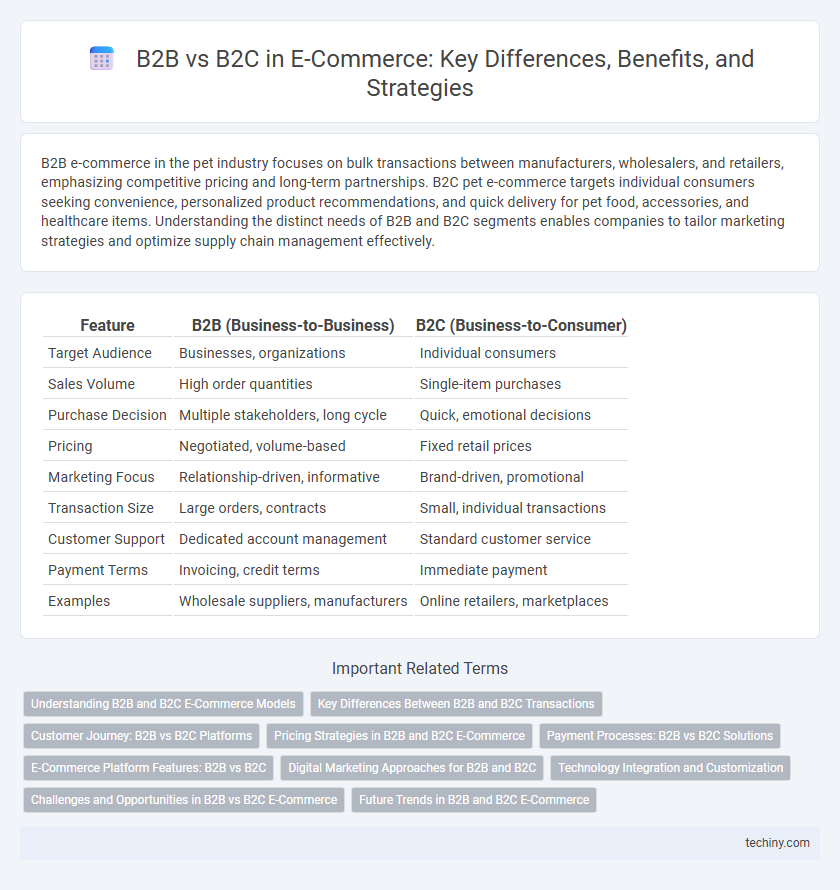B2B e-commerce in the pet industry focuses on bulk transactions between manufacturers, wholesalers, and retailers, emphasizing competitive pricing and long-term partnerships. B2C pet e-commerce targets individual consumers seeking convenience, personalized product recommendations, and quick delivery for pet food, accessories, and healthcare items. Understanding the distinct needs of B2B and B2C segments enables companies to tailor marketing strategies and optimize supply chain management effectively.
Table of Comparison
| Feature | B2B (Business-to-Business) | B2C (Business-to-Consumer) |
|---|---|---|
| Target Audience | Businesses, organizations | Individual consumers |
| Sales Volume | High order quantities | Single-item purchases |
| Purchase Decision | Multiple stakeholders, long cycle | Quick, emotional decisions |
| Pricing | Negotiated, volume-based | Fixed retail prices |
| Marketing Focus | Relationship-driven, informative | Brand-driven, promotional |
| Transaction Size | Large orders, contracts | Small, individual transactions |
| Customer Support | Dedicated account management | Standard customer service |
| Payment Terms | Invoicing, credit terms | Immediate payment |
| Examples | Wholesale suppliers, manufacturers | Online retailers, marketplaces |
Understanding B2B and B2C E-Commerce Models
B2B e-commerce involves transactions between businesses, emphasizing bulk orders, longer sales cycles, and customized pricing structures, while B2C e-commerce targets individual consumers with straightforward purchasing processes, smaller order volumes, and dynamic pricing strategies. Key distinctions include B2B platforms offering complex integration capabilities and account management features, whereas B2C channels prioritize user experience, personalization, and quick checkout options. Understanding these differences allows companies to tailor their digital marketing, sales strategies, and platform functionalities for maximum efficiency and customer satisfaction in each market.
Key Differences Between B2B and B2C Transactions
B2B transactions typically involve larger order volumes, longer sales cycles, and complex negotiation processes compared to B2C, which focuses on individual consumer purchases with shorter decision-making times. Pricing strategies in B2B are often customized and involve bulk discounts, whereas B2C pricing tends to be fixed and prominently displayed. Customer relationships in B2B rely heavily on personalized service and ongoing contracts, while B2C emphasizes brand loyalty through marketing and user experience.
Customer Journey: B2B vs B2C Platforms
B2B e-commerce platforms emphasize complex decision-making processes involving multiple stakeholders, longer sales cycles, and customized pricing models, contrasting with B2C platforms that prioritize quick transactions, personalized experiences, and streamlined checkout processes. B2B customer journeys often require detailed product information, negotiation support, and post-sale service, while B2C journeys focus on user-friendly interfaces, targeted marketing, and rapid fulfillment. Understanding these distinctions enables businesses to tailor their strategies for improved engagement and conversion in respective markets.
Pricing Strategies in B2B and B2C E-Commerce
B2B e-commerce pricing strategies often emphasize volume discounts, negotiated contracts, and tiered pricing models tailored to long-term client relationships, reflecting larger order sizes and recurring purchases. B2C pricing focuses on competitive pricing, promotional discounts, and dynamic pricing algorithms to attract individual consumers driven by price sensitivity and immediate purchase incentives. Leveraging data analytics enables both models to optimize pricing based on buyer behavior, demand fluctuations, and market trends specific to their target audience.
Payment Processes: B2B vs B2C Solutions
B2B payment processes typically involve larger transaction volumes, extended payment terms, and multi-layered approval workflows, requiring advanced solutions like invoicing systems, purchase orders, and credit management tools. B2C payment solutions prioritize speed and simplicity, leveraging instant payment methods such as credit cards, digital wallets, and buy-now-pay-later options to enhance customer experience. Integration with fraud detection, compliance protocols, and seamless checkout experiences are critical differentiators in optimizing payment processes for both B2B and B2C e-commerce environments.
E-Commerce Platform Features: B2B vs B2C
B2B e-commerce platforms emphasize features such as bulk ordering, customizable pricing, and multi-user account management to support complex purchasing workflows and business relationships. In contrast, B2C platforms prioritize user-friendly interfaces, personalized recommendations, and seamless checkout processes to enhance consumer shopping experiences. Both models integrate secure payment gateways and inventory management, but B2B requires advanced contract negotiation tools and extended payment terms for effective transaction handling.
Digital Marketing Approaches for B2B and B2C
B2B digital marketing emphasizes relationship-building and lead nurturing through content marketing, LinkedIn campaigns, and personalized email automation to target specific industries and decision-makers. In contrast, B2C strategies prioritize broad audience engagement using social media ads, influencer partnerships, and dynamic retargeting to drive immediate sales and brand loyalty. Leveraging data analytics and customer journey mapping enhances the effectiveness of both approaches by tailoring messaging and optimizing conversion rates.
Technology Integration and Customization
B2B e-commerce platforms prioritize seamless technology integration with ERP, CRM, and supply chain systems to streamline complex procurement processes and enhance data accuracy. Customization in B2B solutions often involves tailored pricing models, bulk order management, and personalized workflows to meet specific business needs. In contrast, B2C platforms focus on scalable technology for user-friendly experiences, adaptive UI/UX design, and personalized marketing to engage diverse consumer segments effectively.
Challenges and Opportunities in B2B vs B2C E-Commerce
B2B e-commerce faces challenges such as complex transaction processes, longer sales cycles, and the necessity for customized pricing and bulk ordering, whereas B2C e-commerce contends with high customer acquisition costs and intense competition. Opportunities in B2B include leveraging automation for order management and fostering long-term client relationships, while B2C benefits from personalized marketing and rapid customer feedback integration. Both models require advanced technology integrations and data analytics to optimize user experience and drive sales growth.
Future Trends in B2B and B2C E-Commerce
Future trends in B2B e-commerce reveal a growing emphasis on AI-driven personalization, automated procurement processes, and enhanced data analytics to streamline supply chains and improve decision-making. In contrast, B2C e-commerce is rapidly evolving with the integration of augmented reality for immersive shopping experiences, voice-enabled purchasing, and seamless omnichannel strategies to boost customer engagement and loyalty. Both sectors are increasingly adopting blockchain technology for secure transactions and transparent supply networks, driving efficiency and trust across digital marketplaces.
B2B vs B2C Infographic

 techiny.com
techiny.com